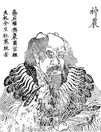
History of Chinese Medicine
Bian stone needles

New Stone Age
8000-2100 BC

circa 2737 BC

2711-2598 BC

407-310 BC

140-207 AD

150-219 AD

215-286 AD

284-364 AD

581-682 AD

1518-1593 AD
1666-1745 AD

“Bian” means use of sharp edge stone to treat disease. Bian stone therapy is the precursor of acupuncture. In the process of using Bian to puncture skin, people began to notice that working on one part of the body often had an effect on another part of the body.
Shen Nong
Founder of Chinese Herbal Medicine/Father of Agriculture
Shen Nong tasted and identified hundreds of herbs, including seventy poisonous ones and determined their medical property and value in time prior to Chinese written history.
"Shennong Ben Cao jing’"(Classic of Materia Medica) was written by Tao Hongjing around 500 AD, based on Shen Nong’s findings. It included 365 medicines for more than 170 diseases. It is the earliest Classic on pharmacology in China and laid foundation for the development of pharmacology in later generation.
Huang Di, Yellow Emperor
Father of Chinese Medicine
Huang Di inquired all aspects of medicine and his conversation with Qi Bo, chief physician, which was recorded and published as “Huang Di Nei Jing” (Inner Cannon of Yellow Emperor) by scholars during Han Dynasty (206BC- 220AD), known as ancient Chinese medical text.
"Huang di Nei Jing" presents the fundamental theories of Chinese Medicine, Including physiology, pathology, meridian system and classification Of diseases, emphasis on prevention, Chinese philosophy based on Taoism, on man’s relationship with Nature and Universe.
"Huang Di Nei Jing" is divided into two parts: Su Wen, (Basic Questions), covering the theoretical foundation of
Chinese Medicine and its diagnostic methods; and Ling Shu, (Spiritual Pivot), which discusses acupuncture therapy in great detail. There was an emphasis on the prevention of disease.
Bian Que
First legendary medical doctor
He originated the Chinese medicine diagnosis- observing, listening, asking, and palpating. He was an excellent diagnostician, exceled in pulse taking and acupuncture. He understood all aspects of medicine – herbs, acupuncture, internal and external medicine, gynecology, pediatrics, geriatrics and disorders of five senses. He could immediately see the root cause, apply the right treatment and achieve the ideal results; therefore, people called him “miracle doctor”, and named him as the spiritual doctor Bian Que.
"Nan Jing" (Classic of Difficulties) written in 206BC-220AD, was a book attributed to Bian Que on pulse examination, five element theory and on 5 shu transport points. It also described using the breathing to increase Qi circulation. Nan Jing is important for those who are interested in pulse diagnosis, Chinese Medicine systemic correspondence and 5 element theory and acupuncture.
Hua Tuo
-Father of surgery
- inventor of anesthesia in Chinese Medicine
He has created Qi Gong Five Animals exercises -tiger, deer, monkey and bird styles – emphasizing the importance of regular physical activity for health. Regular exercise can limber up your joints in the waists and limbs, strengthen the waist, nourish the Viscera, thus achieving the purpose of disease prevention and life prolonging.
Zhang Zhong Jing
Sage of Medicine
Prominent achievement in recognition and treatment of infectious diseases. He established the principle of treatment according to syndrome differentiation from theory to practice.
He wrote "Shang Han Lun" (Discussion on Cold Damage), which emphasized on external disorders – infectious, contagious and epidemic fevers - classified according to 6 stages, with over 260 prescriptions which are the basis of modern clinical practice - the importance of disease in 6 progressions. He also wrote "Jin Gui Yao Lue" (the Golden Cabinet), focused on internal and other diseases of the digestive, respiratory, urological, nervous system and gynecology and classified according to 8 principles differentiation.
Huang Pu Mi
Master of Acupuncture
He compiled the first acupuncture classic titled "Zhen Jiu Jiayijing" (Fundamental Principles of Acupuncture), a book in 12 volumes that systematically organized and summarized Chinese acupuncture knowledge.
It is the first acupuncture book.
Ge Hong
Renowned Alchemist/Pharmacist, Daoist, Physician
He compiled his clinical experiences and published "Zhou Hou Bei Ji Fang" ( Emergency Prescriptions), considered to be a how-to-guide for medical emergencies. For example, he is the first person to treat jaundice with Qing Hao (Artemisia Annuae) and rabid dogs with the brain marrow from attacking dog. The book also included using ephedra sinica in treating asthma, discussed illnesses such as typhoid, malaria, dysentery, smallpox, and cholera which were common during those times.
Sun Simiao
Herbal King/ Daoist alchemist/Ethicist
He is best known for identification and preparation of herbs and for formulation principles. His book "Bei Ji Qian Jin Yao Fang "(Thousands of Golden Prescriptions for Emergencies) is considered to be the first encyclopaedia of Chinese Medicine. Another book, "Qian Jin Yao Fang" (Thousand Ducat Prescription) lists 800 medicinal herbs, including new herbs, and 2000 formulas.
He is the first to present Ethics in medicine, influenced by Taoist philosophy.
Li Shi Zhen
Herbalist, Naturalist, Physician, Pharmacologist
He has written a book derived from 27 years of work, Ben Cao Gang Mu (Compendium of Materia Medica)-documented over 1800 medicinal substances, classfied into 60 categories; brought theory and practice of chinese pharmacology to new heights. This was the most comprehensive of all herbal texts prior to the 17th century.
He has written other books, including Pinghu Maixue ( A Study of the Pulse Diagnosis).
Ye Tian Shi
Famous for his theory on Wen Bing (febrile disease)
He postulated transmission of diseases through 4 stages – Wei, Qi, Ying, and Blood. His most famous work is Wen Re Lun (Discussion on Warm and Hot Disorders, which focused on theories and treatment principles. Ye Gui has greatly influenced the practice of Chinese medicine today.